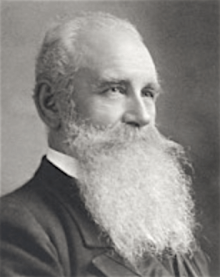
Axel Herman Haig [also known as Axel Haig, Axel Hägg, and as Axel H. Haig] was born in Katthamra on the island of Gotland, Sweden on 10 November 1835. After studying naval architecture and shipbuilding in Karlskrona, in 1856 he moved to Glasgow, Scotland to continue his training. In 1859 he moved to the London office of the architect Ewan Christian (1814-1895).
In 1866 Haig set up his own practice as an architectural draughtsman in London and over the next twenty years produced perspective drawings for some of the leading architects of the day including E. W. Godwin. G. E Street, and most notably William Burges. Haig and Burges maintained a professional relationship which lasted from 1866 to the latter's death 15 years later. Haig created 'realisations' of many of Burges's most important designs including his competition entry for the Royal Courts of Justice in The Strand, and later for Cardiff Castle, Castell Coch, Knightshayes Court, the Speech Room at Harrow School, the Church of Christ the Consoler at Skelton-on-Ure and for Trinity College in Hartford, Connecticut. "In Haig, Burges, the architect of a medieval dreamland, had found an artist worthy of his dreams." [John Mordaunt Crook and C. Lennox-Boyd. Axel Haig and the Victorian Vision of the Middle Ages p.13]. Haig contributed drawings to numerous English magazines, including The Architect. He also produced more than four hundred etchings,
Haig exhibited at the Society of Painter-Etchers and Engravers, Dowdeswell and Dowdeswell, Dudley Gallery, Fine Art Society, Royal Academy, Royal Society of British Artists and the Royal Institute of Painters in Water Colours in London; and at the Walker Art Gallery in Liverpool. He was elected member of the Society of Painter-Etchers and Engravers in 1881, and a member of the Royal Swedish Academy. He was awarded a gold medal at the Exposition Universelle in Paris in 1900.
Haig would spend his summers in Sweden and his winters at Grayshurst, the house he designed for himself in Haslemere, Surrey in 1891, and where he eventually settled.
Apart from Grayhurst, Haig's work as an architect was limited mainly to the resoration of churches including churches at Dalhem (1899–1904) and Ardré (1896–1902) as well as the cathedral at Wisby (1896–1903), all on the island of Gotland. He also designed All Saints Church in Grayswood, Surrey (1901-02)
Haig died in Southsea, Hampshire, England on 23 August 1921.
Crook, John Mordaunt and Lennox-Boyd, C. A. Axel Haig and the Victorian vision of the Middle Ages. London: Allen & Unwin, 1984 [ISBN: 0047200294.]
Directory of British Architects 1834-1914. Compiled by Antonia Brodie, et al. Volume 1: A-K. London; New York: British Architectural Library, Royal Institute of British Architects/Continuum, 2001